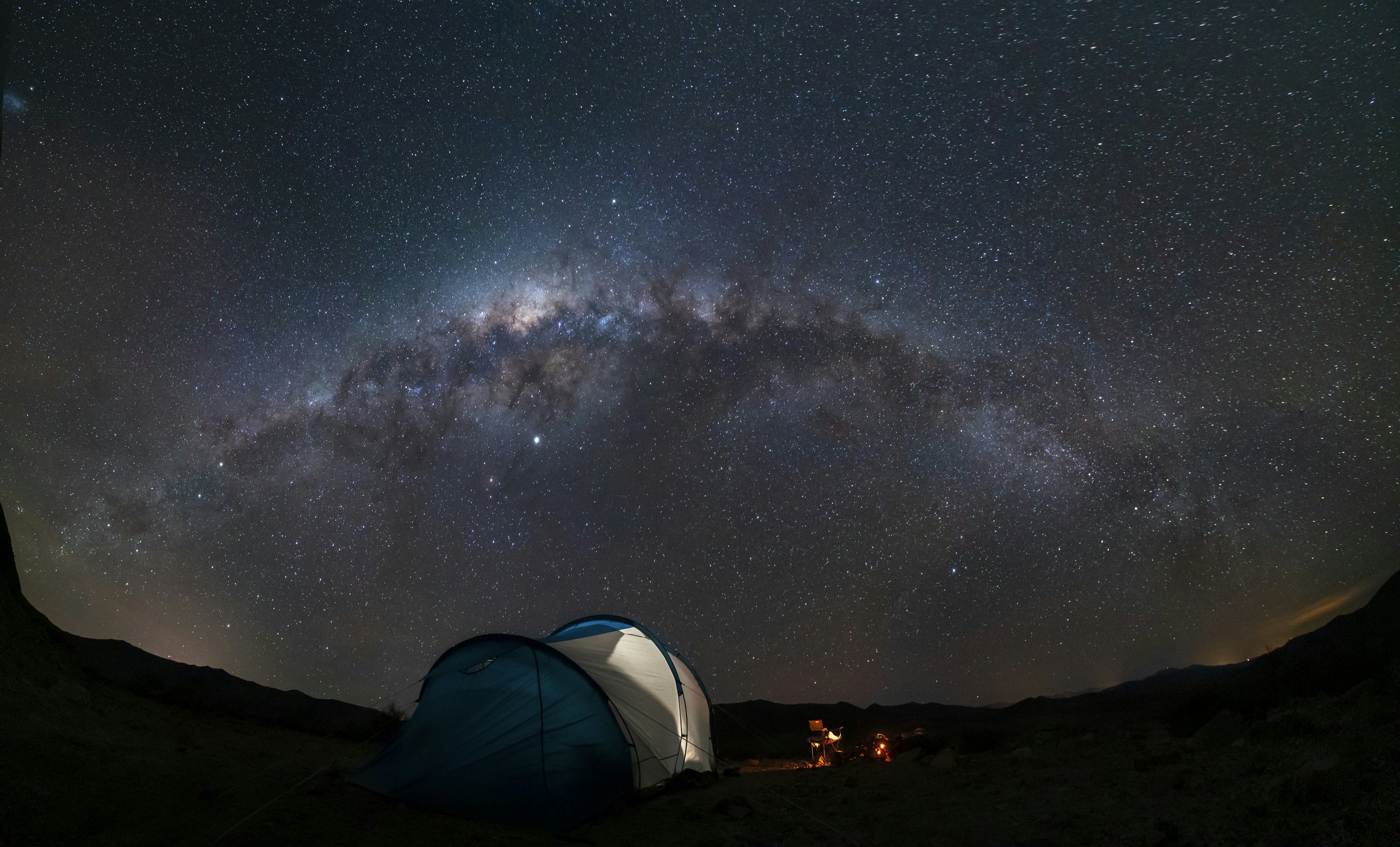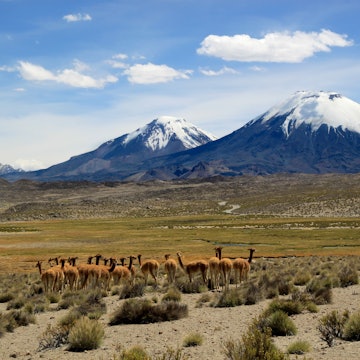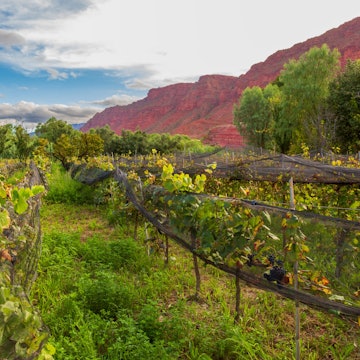
A stargazer’s guide to the Atacama Desert: find the Milky Way with these top tips

Jan 8, 2022 • 6 min read

From finding the ideal conditions to touring world-class observatories, here's what you need to know about stargazing in Chile's Atacama Desert © Eric Hanson / Getty Images
The Atacama Desert unfurls across northern Chile in sizzling salt flats, bone-dry sierras, barren beaches and prickly patches of colorful cacti. Yet, one of its greatest features is only apparent after the sun plunges into the Pacific. That’s when earth’s most lunar-like landscape morphs into a dazzling dome of glittering stars – perfect for the ultimate stargazing trip.
Thanks to a unique combination of low humidity, high altitudes and near non-existent light pollution, the Atacama is home to half of the world’s ground-based astronomy projects. Yet, it’s not just the astronomers who get to geek out over the nightly star show. The Atacama has blossomed in recent years into a global hub for “astro-tourism.” Make the most of a star-studded trip to the world’s driest non-polar desert with the top tips in this beginner's guide.
Elqui Valley and San Pedro de Atacama are the stargazing hubs
For the best stargazing, you’ll want to steer clear of the Pacific coastline, which can be surprisingly cloudy in the mornings and evenings. Instead, base yourself in the interior valleys or up on the Altiplano (the high Andean tableland Chile shares with Bolivia and Peru). The best infrastructure can be found in two key stargazing hubs: Elqui Valley in the Coquimbo Region and San Pedro de Atacama in the Antofagasta Region. The former is just south of the desert proper in a fertile valley known for its pisco and wine production. The latter is the Atacama's most famous oasis, surrounded by high-altitude parklands, sunbaked sand dunes and steaming volcanoes.
Both towns have a good mix of stargazing tours, lodgings, and observatories. The Elqui Valley is a better pick for those who want to pair their nighttime neck-craning with daytime drinking at solar-powered craft breweries, experimental high-altitude vineyards or one of a half-dozen pisco distilleries. Vicuña is the most logical base for stargazing here with the quickest access to nearby observatories. Pisco Elqui, further up in the valley, is filled with yoga studios, New Age retreat centers, and alternative therapies. San Pedro de Atacama lies in the middle of the desert and is one of Chile’s most popular resort towns. It has a greater array of restaurants and accommodations than the Elqui Valley and tends to draw a more international crowd. With large geyser fields, flamingo-filled lagoons and ancient ruins, it makes a good base for those who want to fill the daylight hours with epic outdoor adventures.
A first-timer’s guide to Chile’s Atacama Desert

There are several tourist-friendly observatories and astro-tours
Elqui Valley has the largest array of tourist-friendly observatories in the Atacama, most of which are located near Vicuña. Observatorio Cerro Mamalluca draws the biggest crowds with its two-hour English-language tours, which start with a sky lecture and segue into stargazing through a 12-inch telescope. Observatorio Cancana runs a similar program with two 14-inch telescopes, while Observatorio del Pangue offers the largest publicly-accessible telescope in the region at 25 inches of aperture, plus an enviable hilltop location within sight of where the professionals work at Observatorio Interamericano Cerro Tololo.
San Pedro de Atacama has less observatories than the Elqui Valley but more astro-tours, which take you to remote patches of the desert where you can learn how to identify dwarf galaxies, such as the Magellanic Clouds, from supernova remnants, such as the Crab Nebula. The leading agency here, SPACE, offers educational star tours at the largest park of public telescopes in South America (it also has the largest single publicly-available telescope at 45 inches). Guides teach you how to read a sky map and recognize the main stars visible in the Southern Hemisphere.
Learn about the night sky from an Indigenous perspective
If you spend one night getting a scientific appreciation for the night sky, it’s helpful to spend the next looking at the cosmos from an Indigenous perspective. Astro Elqui, in Vicuña, combines performances, chats and astronomical observations for a three-hour experience exploring the Andean cosmovision of the local Diaguita culture. Observatorio Etno-Astronomico Licanantay offers a similar “ethno-astronomical tour” near San Pedro that helps visitors understand the Andean night sky as it was viewed for centuries by the Indigenous Atacameño people. You’ll learn about how ancestral knowledge of the stars informed local agricultural practices, as well as peer into the Milky Way to discover messages hidden within its dark spots.

See professional astronomers at work
You won’t be able to probe the night sky at the Atacama’s professional observatories, but guided visits offer a fascinating peek behind the curtain at the life and work of the world’s top astronomers, who are searching for the answers to questions many of us haven’t even thought to ask. Observatorio Interamericano Cerro Tololo and La Silla, both near the Elqui Valley, are the most equipped to handle tourists. Both offer tours on weekends, which must be reserved well in advance.
The $1.4 billion Atacama Large Millimeter/submillimeter Array (ALMA), near San Pedro, is the largest and most expensive ground-based astronomical project in existence. While you can’t travel up to 5050m (16,570ft) to see its 66 radio telescopes – which move in unison along the Chajnantor Plateau – you can visit the ALMA Operations Support Facility down below on weekends with a prior reservation.

Stay at hotels and campsites that are ideal for stargazing
Camping is, naturally, one of the cheapest and easiest ways to foster a deep connection with the stars above. In the Elqui Valley, most campsites lie in the shade of willow trees along the rambling river below Pisco Elqui, with emerald green watering holes where you can escape the midday heat. Just remember that temperatures drop considerably in the evening, particularly in winter when it can dip below zero. The same is true of San Pedro de Atacama, which has more than a dozen campgrounds on the periphery of town. The best sites have tent shelters that’ll protect you from both the walloping winds and the midday heat.
Another budget option for stargazing enthusiasts is Alfa Aldea in Vicuña, which has its own onsite telescope and star tours. Those with a more flexible budget should head to Elqui Domos, where clear-top domes let you count stars from the comfort of your bed. Atacama Lodge near San Pedro is another mid-range option that caters exclusively to amateur astronomers. Though Elqui Valley is home to the impeccably designed Casa Molle, it’s San Pedro that holds the lion’s share of luxury lodges. The best for stargazers is the Nayara Alto Atacama, which has a 16-inch telescope on a hill above the hotel for nightly stargazing sessions.
The Atacama Desert is on our 2022 Best of Travel list. For more stories from some of the world’s most exciting destinations click here.
Safety recommendations and restrictions during a pandemic can change rapidly. Lonely Planet recommends that travelers always check with local authorities for up-to-date guidance before traveling during COVID-19.
You might also like:
The best road trips in Chile: From Patagonia to the Atacama Desert
The best things to do in Chile: volcanoes, surfing and pisco sours
Stargazing essentials to help you contemplate the cosmos















